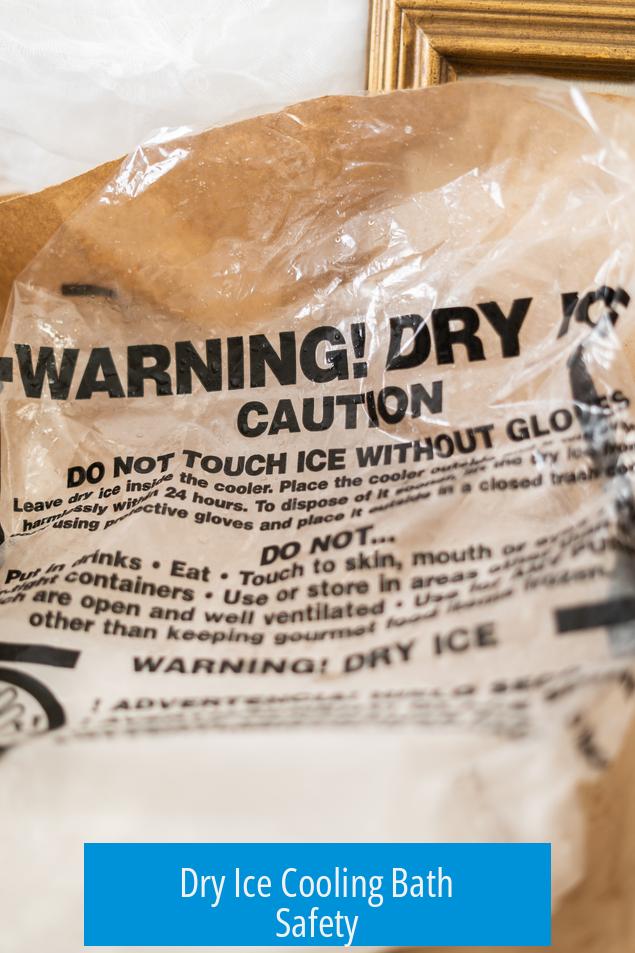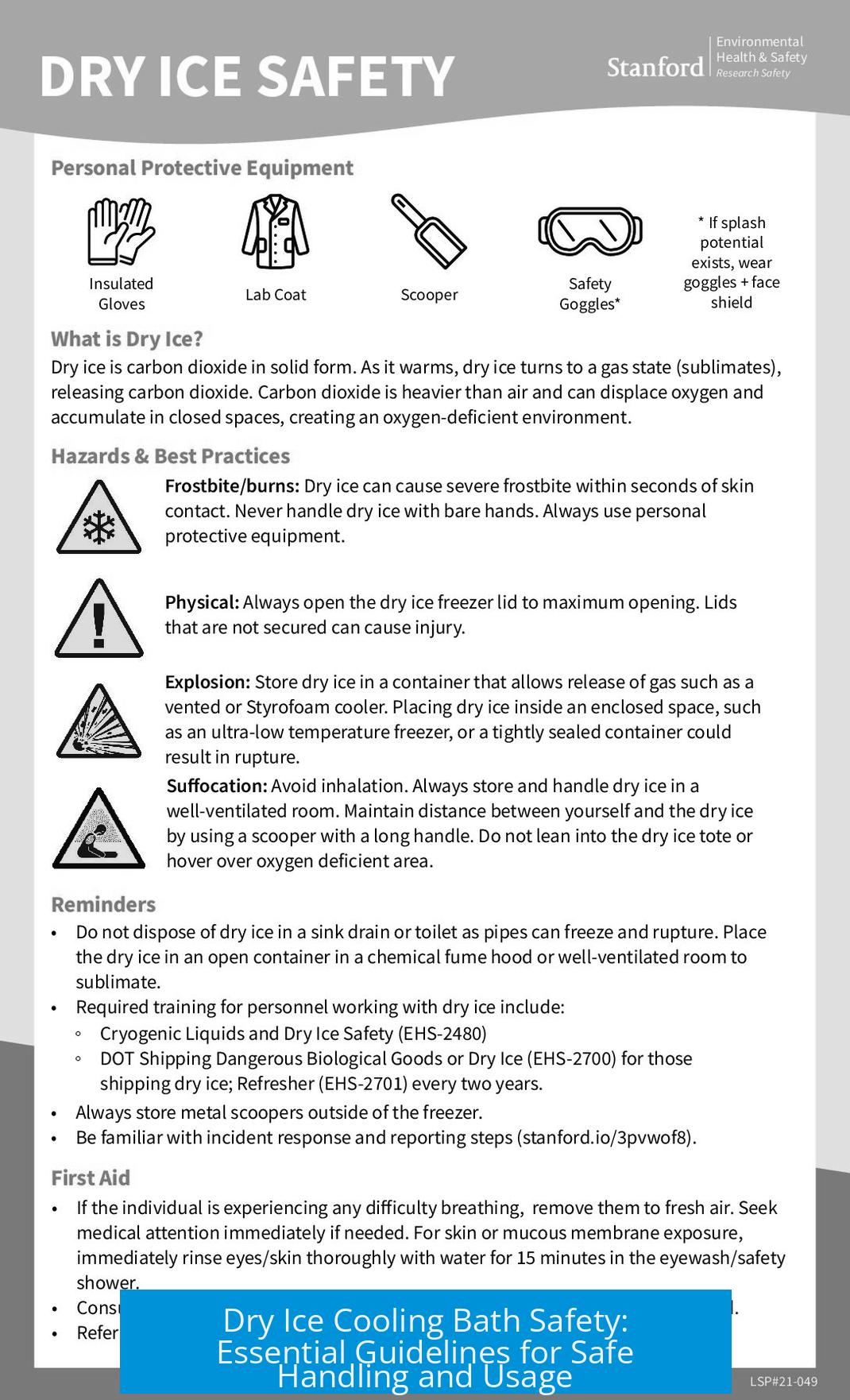Dry Ice Cooling Bath Safety

Dry ice cooling baths can be safe if handled properly, with correct equipment, protective measures, and awareness of the chemical and physical hazards involved. Key safety points involve using proper containers, careful mixing, personal protective equipment, and understanding dry ice behavior.
1. Handling and Equipment
1.1 Use of Dewars
Dry ice baths require special containers such as Dewars. These vacuum-insulated vessels withstand rapid temperature changes better than standard glassware.
Dewars can explode if exposed to sudden thermal shocks. Use only Dewars designed for extremely cold materials. Avoid simple glass ice baths. Never immerse fingers in the bath.
1.2 Proper Mixing Procedure

Start with adding about one-quarter of the ethanol volume estimated for the bath. Transfer dry ice chunks slowly using insulated gloves or tongs. Wait for bubbling to subside before inserting glassware or flasks. Add dry ice gradually at the desired cooling level. Pour ethanol down the flask walls, not directly on dry ice.
This method reduces vigorous bubbling and bumping. Prepare a “slushee” by chunking dry ice first, then slowly adding ethanol. Adding dry ice to ethanol directly causes intense boiling and spillage.
1.3 Bubbling and Sample Handling
Expect vigorous bubbling when mixing dry ice and ethanol. It intensifies when introducing warmer objects or solvents. The frothing can obscure the sample’s position. Mark sample containers clearly, as labels may wash off.
2. Personal Safety and Protective Equipment
2.1 Gloves and Skin Protection
- Wear nitrile or latex gloves resistant to chemicals used.
- Gloves provide limited insulation against extreme cold but reduce skin exposure.
- A brief direct touch of dry ice is sometimes tolerated due to CO2 gas insulation, but in dry ice/ethanol mixtures, direct skin contact causes frostbite quickly.
Remove any exposed skin promptly to avoid cold burns. Gloves minimize risk.
2.2 Avoiding Direct Contact and Thermal Burns
Do not stick fingers or unprotected skin in the bath. Unlike solid dry ice, the Leidenfrost effect (which forms a protective gas layer) is less effective here. Always handle with caution.
3. Handling Dry Ice and Chemicals
3.1 Adding Dry Ice Slowly
Add dry ice chunks one at a time. This prevents violent boiling and spillage.
3.2 Chemical Awareness and Disposal
- Understand the chemicals’ hazards and proper disposal methods.
- Never drink or seal dry ice containers airtight, as gas buildup can cause rupture.
- Do not pour ethanol or dry ice slurry down drains without proper neutralization.
4. General Advice and Cautions
4.1 Ask for Help and Training
Seek advice from experienced personnel if unsure. Laboratory instructors or technicians provide essential guidance for safe procedures.
4.2 Confidence and Safe Mindset
Working with dry ice baths requires calm and confidence. Fear leads to mistakes. Prepare thoroughly and execute with care.
5. Physical Properties and Heat Transfer
5.1 Temperature and Cooling Efficiency
Dry ice baths achieve temperatures significantly below freezing, often around −78 °C. The liquid solvent (ethanol or acetone) enhances heat transfer compared to solid dry ice alone.
5.2 Thermal Effects
The bath’s extreme cold increases risks of thermal burns. Unlike solid dry ice, the liquid bath does not insulate hands via the Leidenfrost effect. Direct contact causes rapid frostbite.
Key Takeaways
- Use Dewars designed for extreme cold to hold dry ice baths.
- Add dry ice slowly to ethanol, pour ethanol gently to control bubbling.
- Wear chemical-resistant gloves to protect skin from frostbite and chemicals.
- Avoid direct contact with the bath to prevent thermal burns.
- Know chemical hazards and follow proper disposal protocols.
- Ask experienced colleagues if unsure and maintain a confident, cautious approach.
What precautions should I take when using a dewar for a dry ice cooling bath?
Use a proper dewar, not a simple glass container. Dewars can explode from thermal shocks. Avoid sticking fingers inside it to prevent injury.
How do I safely mix dry ice with ethanol in a cooling bath?
Add about 1/4 of the expected ethanol first. Then add dry ice slowly using insulated gloves or tongs. Top up ethanol carefully by pouring along the flask, not directly on dry ice to avoid bumping.
What personal protective equipment is recommended when handling dry ice baths?
Wear nitrile or latex gloves resistant to your chemicals. Gloves offer some protection from frostbite. Avoid direct skin contact; remove your hand quickly if it touches cold surfaces.
Why does the dry ice cooling bath bubble so much, and how should I handle it?
Mixing dry ice and ethanol causes heavy bubbling initially and when adding warm samples. Plan to avoid spills, and don’t rely on labels on glassware as markings may wash off.
How should dry ice chunks be added to the bath to ensure safety?
Add one chunk of dry ice at a time slowly. This reduces violent reactions and manages bubbling in the bath effectively.
What should I do if I am unsure about handling a dry ice cooling bath?
Ask for help from someone experienced, like a TA or supervisor. Getting guidance ensures correct and safe procedures.





Leave a Comment